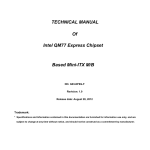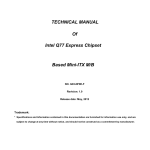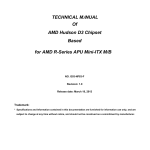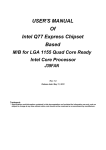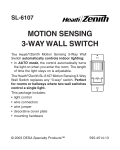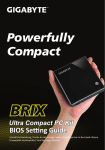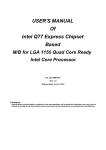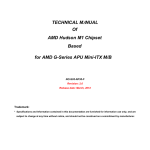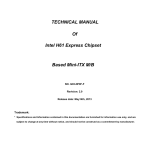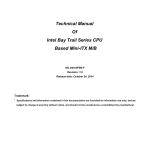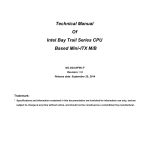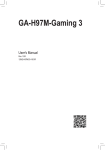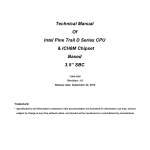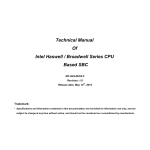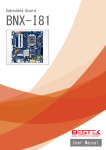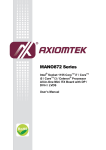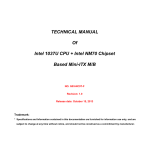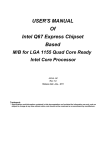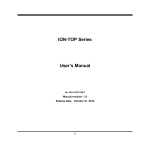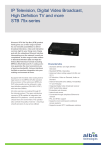Download USER`S MANUAL Of Intel Q87 Express Chipset Based
Transcript
USER'S MANUAL Of Intel Q87 Express Chipset Based M/B for LGA 1150 Quad Core Ready Intel Core Processor J59FAN Rev: 1.0 Release date: July 25, 2013 Trademark: * Specifications and Information contained in this documentation are furnished for information use only, and are subject to change at any time without notice, and should not be construed as a commitment by manufacturer. TABLE OF CONTENT ENVIRONMENTAL SAFETY INSTRUCTION........................................................................... iii ENVIRONMENTAL PROTECTION ANNOUCEMENT.............................................................. iii USER’S NOTICE ....................................................................................................................... iv MANUAL REVISION INFORMATION ....................................................................................... iv ITEM CHECKLIST ..................................................................................................................... iv CHAPTER 1 INTRODUCTION OF THE MOTHERBOARD 1-1 SPECIFICATION ......................................................................................................... 1 1-2 LAYOUT DIAGRAM.................................................................................................... 2 CHAPTER 2 HARDWARE INSTALLATION 2-1 JUMPER SETTING ..................................................................................................... 5 2-2 CONNECTORS AND HEADERS................................................................................ 10 2-2-1 REAR I/O BACK PANEL CONNECTORS.................................................... 10 2-2-2 MOTHERBOARD INTERNAL CONNECTORS ............................................ 11 2-2-3 HEADER PIN DEFINITION ........................................................................... 13 CHAPTER 3 INTRODUCING BIOS 3-1 ENTERNING SETUP................................................................................................... 18 3-2 BIOS MENU SCREEN ................................................................................................ 18 3-3 FUNCTION KEYS ....................................................................................................... 19 3-4 GETTING HELP .......................................................................................................... 19 3-5 MENU BARS ............................................................................................................... 20 3-6 MAIN MENU ................................................................................................................ 20 3-7 ADVANCED MENU..................................................................................................... 21 3-8 CHIPSET MENU.......................................................................................................... 28 3-9 BOOT MENU ............................................................................................................... 30 3-10 SECURITY MENU ....................................................................................................... 31 3-11 SAVE & EXIT MENU................................................................................................... 32 ii Environmental Safety Instruction z Avoid the dusty, humidity and temperature extremes. Do not place the product in any area where it may become wet. z 0 to 40 centigrade is the suitable temperature. (The figure comes from the request of the main chipset) z Generally speaking, dramatic changes in temperature may lead to contact malfunction and crackles due to constant thermal expansion and contraction from the welding spots’ that connect components and PCB. Computer should go through an adaptive phase before it boots when it is moved from a cold environment to a warmer one to avoid condensation phenomenon. These water drops attached on PCB or the surface of the components can bring about phenomena as minor as computer instability resulted from corrosion and oxidation from components and PCB or as major as short circuit that can burn the components. Suggest starting the computer until the temperature goes up. z The increasing temperature of the capacitor may decrease the life of computer. Using the close case may decrease the life of other device because the higher temperature in the inner of the case. z Attention to the heat sink when you over-clocking. The higher temperature may decrease the life of the device and burned the capacitor. Environmental Protection Announcement Do not dispose this electronic device into the trash while discarding. To minimize pollution and ensure environment protection of mother earth, please recycle. iii USER’S NOTICE COPYRIGHT OF THIS MANUAL BELONGS TO THE MANUFACTURER. NO PART OF THIS MANUAL, INCLUDING THE PRODUCTS AND SOFTWARE DESCRIBED IN IT MAY BE REPRODUCED, TRANSMITTED OR TRANSLATED INTO ANY LANGUAGE IN ANY FORM OR BY ANY MEANS WITHOUT WRITTEN PERMISSION OF THE MANUFACTURER. THIS MANUAL CONTAINS ALL INFORMATION REQUIRED TO USE THIS MOTHER-BOARD SERIES AND WE DO ASSURE THIS MANUAL MEETS USER’S REQUIREMENT BUT WILL CHANGE, CORRECT ANY TIME WITHOUT NOTICE. MANUFACTURER PROVIDES THIS MANUAL “AS IS” WITHOUT WARRANTY OF ANY KIND, AND WILL NOT BE LIABLE FOR ANY INDIRECT, SPECIAL, INCIDENTAL OR CONSEQUENTIAL DAMAGES (INCLUDING DAMAGES FOR LOSS OF PROFIT, LOSS OF BUSINESS, LOSS OF USE OF DATA, INTERRUPTION OF BUSINESS AND THE LIKE). PRODUCTS AND CORPORATE NAMES APPEARING IN THIS MANUAL MAY OR MAY NOT BE REGISTERED TRADEMARKS OR COPYRIGHTS OF THEIR RESPECTIVE COMPANIES, AND THEY ARE USED ONLY FOR IDENTIFICATION OR EXPLANATION AND TO THE OWNER’S BENEFIT, WITHOUT INTENT TO INFRINGE. Manual Revision Information Reversion 1.0 Revision History First Edition Date July 25, 2013 Item Checklist 5 5 5 5 5 Motherboard User’s Manual DVD for motherboard utilities Cable(s) I/O Back panel shield iv Chapter 1 Introduction of the Motherboard 1-1 Specification Spec Design Chipset LGA1155 CPU Socket Memory Slot Expansion Slots Storage Dual LAN Chips HD Audio Chip BIOS Description z z ATX form factor; PCB size: 30.5 x24.5 cm Intel® Q87 Express Chipset Supports Intel® Core™ i7, Core™ i5, Core™ i3 series, Pentium® processor in LAG1150 Package * for detailed CPU support information please visit our website z DDRIII RAM module slot x 4 z Supporting four DDRIII 1600/1333/1066MHz RAM Module expandable to 32 GB (Maximum) z Support dual-channel function z 1 pcs* PCI-Express x16 slot (PE1) z 1 pcs* PCI-Express x4 slot (PE2) z 1 pcs* PCI-Express x1 slot (PE3) z 4 pcs *32-bit PCI slot z 1 pcs* Full-size Mini-PCIE slot (PE4) z 1 pcs* Full-size MSATA slot z 6 * SATAIII 6Gb/s ports support RAID 0, 1, 5, 10 function z z z z z Integrated Intel® 82574L and i217-LM Gigabit Ethernet LAN chip that supports Fast Ethernet LAN function of providing 10/100/1000Mbps Ethernet data transfer rate Realtek ALC662 6-channel Audio Codec integrated Audio driver and utility included 64M Bit DIP Flash ROM Rear Panel I/O: z z z z z z z z z Serial port connector x1 Display port connector x1 HDMI port connector x1 DVI-D port connector x1 VGA port connector x1 USB 3.0 port connector x2 USB 2.0 port connector x4 RJ-45 LAN connector x2 Audio connector x3 (Line-in, Line-out, MIC) z z z z z z z z z z z z z z z z z 1 *24-pin main power connector 1 *8-pin 12V Power connector Front panel audio header x1 CDIN header x1 HDMI-SPDIF header x1 PS/2 KB & MS header x1 GPIO header x1 CIR header x1 TPM 1.2 header x1 USB 3.0 header x1 (support two expansion USB 3.0 ports) USB 2.0 header x2 (support four expansion USB 2.0 ports) Front panel header x1 POWER LED1+Speaker header x1 COM port header x 9 SM_BUS header x1 LANLED header x2 Fan header x 3 Internal I/O Connectors& Headers: Multi I/O 1 1-2 Layout Diagram Rear IO Diagram RJ-45 LAN Ports Serial Port USB 3.0 Ports VGA Port Line-IN/ Optical SPDIF OUT Line-OUT MIC-IN Display Port HDMI Port DVI-D Port USB 2.0 Ports Motherboard Internal Diagram CPUFAN Header SYS FAN1 Header Serial Port over Display Port ATX 12V Power Connector USB 3.0 Ports over HDMI Port VGA Port over DVI–D Port DDRIII DIMM Slot x 4 LGA 1150 CPU Socket ATX Power Connector RJ-45 LAN Ports Over USB 2.0 Ports RJ-45 LAN Ports Over USB 2.0 Ports Audio Connectors PCI Express x16 Slot (PE1) Intel Q87 Chipset PCI Express 2.0 x 4 Slot (PE2) SM_BUS Header Full-size PCI Express 2.0 x1 Slot (PE3)Mini-PCIE Slot SATAIII Ports (PE4) * Full-size MSATA Slot (MSATA) Serial Ports (COM2/3/4/5/6/7/8/9/10) KBMS Header 32-bit PCI Slots HDMI S/PDIF Header Front Panel Audio Header CDIN Header NICLED Headers PWR LED +Speaker Header (JP15) USB 2.0 Headers TPM Header GPIO Header USB 3.0 Header CIR Header SYS FAN2 Header Front Panel Header *Notice: 1. PE4 slot functions as full-size Mini-PCIE slot and shares function with PE3, i.e. only one can function at a time.2. MSATA slot shares function with SATA6 port; user can only choose one to use at one time. 2 Motherboard Jumper Position JP1 JBAT JP7 JP2 JP5 JP6 JP4 JP8 JP14 CASE_OPEN JP13 JP9 JP12 JP10 Jumper Jumper JP1 JP9 JP5 JP6 JP7 JP8 JP10 JP11 JP12 JP13 JP14 JBAT JP2 JP4 Case_OPEN JP11 Name COM1 Port Pin9 Function Select COM2 Header Pin9 Function Select COM3 Header Pin9 Function Select COM5 Header Pin9 Function Select COM7 Header Pin9 Function Select COM9 Header Pin9 Function Select COM4 Header Pin9 Function Select COM6 Header Pin9 Function Select COM8 Header Pin9 Function Select COM10 Header Pin9 Function Select ME_Features Select CMOS RAM Clear Function Setting Mini PCI-E Slot (PE4)VCC3.3V/3.3VSB Select MSATA Slot (MSATA)VCC3.3V/3.3VSB Select Case Open Message Display Function Select 3 Description 4-pin Block 4-pin Block 4-pin Block 4-pin Block 4-pin Block 4-pin Block 4-pin Block 4-pin Block 6-pin Block 6-pin Block 2-pin Block 3-pin Block 3-pin Block 3-pin Block 2-pin Block Connectors Connector ATXPWR ATX12V COM1 Name ATX Power Connector ATX 12V Power Connector Serial Port COM Connector DP USB1 HDMI Display Port USB 3.0 Connector X2 High-Definition Multimedia Interface CRT DVI1 UL1(Top)/UL2(Top) UL1(Middle & Bottom)/UL2(Middle & Bottom) AUDIO Video Graphic Attach Connector DVI-D Port Connector RJ-45 LAN Connector X2 USB 2.0 Port Connector X4 Line Out /Line In /MIC Audio Connector SATAIII Connector X6 SATA1/2/3/4/5/6 Headers Header Name FP_AUDIO Front Panel Audio Header CD_IN CD Audio-In Header HDMI_SPDIF HDMI_SPDIF Out Header KBMS PS/2 Keyboard & Mouse Header GPIO_CON GPIO Header CIR_CON CIR Header TPM TPM Header USB2 USB 3.0 Header USB3/USB4 USB 2.0 Header JW_FP PWR LED/ HD LED/ /Power Button (Front Panel Header) /Reset JP15 Power LED+ Speaker Header COM 2/3/4/5/6/7/8/9/10 Serial Port Header SM_BUS SMBUS Header NIC_LED1/ NIC_LED2 LANLED Activity Header SYSFAN1/SYSFAN2/CPUFAN FAN Header 4 Description 9-pin Block 4-pin Block 2-pin Block 6-pin Block 10-pin Block 7-pin Block 19-pin Block 19-pin Block 9-pin Block 9-pin Block 7-pin Block 9-pin Block 4-pin Block 2-pin Block 4-pin Block Chapter 2 Hardware Installation 2-1 Jumper Setting JP1 (4-pin): COM1 Port Pin9 Function Select JP1→COM1 Port 2 4 6 2 4 6 2 4 6 1 3 5 1 3 5 1 3 5 2-4 Closed: RI=RS232 3-4 Closed: RI= 5V; 4-6 Closed: RI= 12V; 2 4 6 2 4 6 2 4 6 1 3 5 1 3 5 1 3 5 2-4 Closed: RI=RS232 3-4 Closed: RI= 5V; 4-6 Closed: RI= 12V; 2 4 6 2 4 6 2 4 6 1 3 5 1 3 5 1 3 5 2-4 Closed: RI=RS232 3-4 Closed: RI= 5V; 4-6 Closed: RI= 12V; JP9 (4-pin): COM2 Header Pin9 Function Select JP9→COM2 Header JP5 (4-pin): COM3 Header Pin9 Function Select JP5→COM3 Header 5 JP6 (4-pin): COM5 Header Pin9 Function Select JP6→COM5 Header 2 4 6 2 4 6 2 4 6 1 3 5 1 3 5 1 3 5 2-4 Closed: RI=RS232 3-4 Closed: RI= 5V; 4-6 Closed: RI= 12V; 2 4 6 2 4 6 2 4 6 1 3 5 1 3 5 1 3 5 2-4 Closed: RI=RS232 3-4 Closed: RI= 5V; 4-6 Closed: RI= 12V; 2 4 6 2 4 6 2 4 6 1 3 5 1 3 5 1 3 5 2-4 Closed: RI=RS232 3-4 Closed: RI= 5V; 4-6 Closed: RI= 12V; JP7 (4-pin): COM7 Header Pin9 Function Select JP7→COM7 Header JP8 (4-pin): COM9 Header Pin9 Function Select JP8→COM9 Header 6 JP10 (4-pin): COM4 Header Pin9 Function Select JP10→COM4 Header 2 4 6 2 4 6 2 4 6 1 3 5 1 3 5 1 3 5 2-4 Closed: RI=RS232 3-4 Closed: RI= 5V; 4-6 Closed: RI= 12V; JP11 (4-pin): COM6 Header Pin9 Function Select JP11→COM6 Header 2 4 6 2 4 6 2 4 6 1 3 5 1 3 5 1 3 5 2-4 Closed: RI=RS232 3-4 Closed: RI= 5V; 4-6 Closed: RI= 12V; 2 4 6 2 4 6 2 4 6 1 3 5 1 3 5 1 3 5 2-4 Closed: RI=RS232 3-4 Closed: RI= 5V; 4-6 Closed: RI= 12V; JP12 (4-pin): COM8 Port Pin9 Function Select JP12→COM8 Header 7 JP13 (4-pin): COM10 Port Pin9 Function Select JP13→COM10 Header 2 4 6 2 4 6 2 4 6 1 3 5 1 3 5 1 3 5 2-4 Closed: RI=RS232 3-4 Closed: RI= 5V; 4-6 Closed: RI= 12V; JP14 (2-pin): ME Features Select JP14 1 2 1-2 Open:ME Features Enabled; 1 2 1-2 Closed:ME Features Disabled. JBAT (3-pin): Clear CMOS Function Settings JBAT 1 3 1-2 Closed: Normal; 1 3 2-3 Closed: Clear CMOS. 8 JP2 (3-pin): Mini PCI-E (PE4) Slot VCC 3.3V/3.3 VSB Select JP2→PE4 Slot 1 3 1-2 Closed : MINI PCI-E VCC= 3.3V; 1 3 2-3 Closed : MINI PCI-E VCC= 3.3VSB JP4 (3-pin): MSATA Slot VCC 3.3V/3.3 VSB Select JP4→MSATA 1 3 1-2 Closed: MSATA VCC= 3.3V; 1 3 2-3 Closed: MSATA VCC= 3.3VSB CASE_ OPEN (2-pin): Case Open Message Display Function Select CASE_OPEN 1 2 1-2 Open: Normal; 1 2 1-2 Closed : Case Open Function Selected. Pin 1-2 Closed: Case open display function enabled. Use needs to enter BIOS and enable ‘Case Open Detect’ function. In this case if you case is removed, next time when you restart your computer a message will be displayed onscreen to inform you of this. 9 2-2 Connectors and Headers 2-2-1 Rear I/O Back Panel Connectors RJ-45 LAN Ports Serial Port USB 3.0 Ports VGA Port Line-IN/ Optical SPDIF OUT Line-OUT MIC-IN Display Port HDMI Port DVI-D Port USB 2.0 Ports (1) Serial port Connector: COM1 These two serial ports are for user to connect compatible mouse, modern or other peripherals. (2) Display Port: DP Display port can support a maximum screen resolution of 2560 x 1600 (actual resolution depending on the monitor used) and high-quality audio playback. Please connect it to your monitor with DP cable if your monitor support display port. (3) USB 3.0 Port Connector: USB1 These USB 3.0 connectors are for user to connect USB 3.0 compatible devices to the system board. (4) High-Definition Multimedia Interface: HDMI This point-to-point interface is for audio and video signals designed as a single-cable solution for home theater and consumer electronics equipment. (5) D-Sub 15-pin VGA Connector: CRT VGA connector is the 15-pin D-subminiature female connector; it is for the display devices, such as the CRT monitor, LCD monitor and so on. (6) Digital Visual Interface: DVI1 This interface standard designed to maximize the visual quality of digital display devices such as flat panel LCD computer displays and digital projectors. (7) USB 2.0 Port Connector: UL1(Middle & Bottom)/ UL2(Middle & Bottom) The connectors are 4-pin connector that connects USB devices to the system board. (8) RJ-45 LAN Port Connectors: UL1(Top)/UL2(Top) The connectors are standard RJ-45 connectors for Network. (9) Line-In(SPDIF Out), Lin-Out, MIC Audio connectors: AUDIO1 These Connectors are 3 Phone-Jack for LINE-OUT, LINE-IN, MIC audio connections. Color Name Function Blue Line-in/SPDIF Out Audio input to sound chip/SPDIF Out Connector Green Line-out Audio output to speaker Pink MIC Microphone Connector 10 2-2-2 Motherboard Internal Connectors (1) ATXPWR (24-pin block): Main Power Connector ATX Power Supply connector: This is a new defined 24-pins connector that usually comes with ATX case. The ATX Power Supply allows using soft power on momentary switch that connect from the front panel switch to 2-pins Power On jumper pole on the motherboard. When the power switch on the back of the ATX power supply turned on, the full power will not come into the system board until the front panel switch is momentarily pressed. Press this switch again will turn off the power to the system board. ** We recommend that you use an ATX 12V Specification 2.0-compliant power supply unit (PSU) with a minimum of 350W power rating. This type has 24-pin and 4-pin power plugs. ** If you intend to use a PSU with 20-pin and 4-pin power plugs, make sure that the 20-pin power plug can provide at least 15A on +12V and the power supply unit has a minimum power rating of 350W. The system may become unstable or may not boot up if the power is inadequate. ** If you are using a 20-pin power plug, please refer to Figure1 for power supply connection. Power plug form power supply and power connectors from motherboard both adopt key design to avoid mistake installation. You can insert the power plug into the connector with ease only in the right direction. If the direction is wrong it is hard to fit in and if you make the connection by force if is possible. PIN 1 2 3 4 5 6 7 8 9 10 11 12 ROW1 +3.3V +3.3V GND +5V GND +5V GND Power OK +5V Stand by +12V +12V +3.3V ROW2 +3.3V -12V GND Soft Power on GND GND GND -5V +5V +5V +5V GND 24-pin Main Power Connector Figure1:20-pin power plug Figure 2:24-pin power plug 11 (2) ATX12V (8-pin block): 12V Power Connector This is a new defined 8-pin connector that usually comes with ATX Power Supply that supports extra 12V voltage to maintain system power consumption. Without this connector might cause system unstable because the power supply can not provide sufficient current for system. Pin1 4 Pin Definition No. Definition 1 GND 5 +12V 2 GND 6 +12V 3 GND 7 +12V 4 GND 8 +12V (3) SATA1/2/3/4/5/6: SATAIII Port connector These connectors are high-speed SATAIII ports that support 6 GB/s transfer rate. 12 Pin No. Defnition 1 GND 2 TXP 3 4 TXN GND 5 RXN 6 RXP 7 GND 2-2-3 Header Pin Definition (1) FP_AUDIO (9-pin): Line-Out, MIC-In Header This header is connected to Front Panel Line-out, MIC connector with cable. FP_AUDIO NC NC NC GND 2 Pin 1 LINE OUT-L NC LINE OUT-R MIC1-L MIC1-R Line-Out, MIC Header (2) CD_IN (4-pin): CD AUDIO-In Header CDIN header is for CD-Audio Input signal. CD-Audio output connector. Please connect it to CD-ROM CD-R GND GND CD-L Pin1 (3) HDMI_SPDIF (2-pin): HDMI-SPDIF Out header GND SPDIF Pin1 HDMI_SPDIF Header 13 (4) KBMS (6-pin): PS/2 Keyboard & Mouse Header MS_DATA MS_CLK GND KB_CLK KB_DATA VCC Pin1 (5) GPIO_CON (10-pin): GPIO Header VCC GPIO GPIO GPIO GPIO 10 9 2 Pin 1 GND GPIO GPIO GPIO GPIO (6) CIR_CON (7-Pin): CIR Header CIR RX VCC CIR _WB CIR LED 2 Pin 1 ATX 5VSB NC GND CIR Header 14 (7) TPM (19-pin): TPM Header GPIO NC /GND SERIRQ SMB_DATA GND LAD1 LAD2 VCC5V KEY/NC GND Pin 1 2 LPC_PDGND SB 3.3V SMB_CLK LAD0 VCC3.3 LAD3 RESET LFRAMECLK (8) USB 3.0 Port Header (19-pin): USB2 VBUS2 SSRX2SSRX2+ GND3 SSTX2SSTX2+ GND2 D2D2+ 11 VBUS SSRX1SSRX1 + GND0 SSTX1SSTX1+ GND1 D1D1+ NC NC GND +DATA -DATA VCC VCC GND +DATA -DATA 15 Pin 1 10 (9) USB 2.0 Port Headers (9-pin): USB3/USB4 Pin 1 (10) JW-FP (9-pin): Front Panel Header PWRBTN PWR LED P WRLED- HDDLED+ G ND HDDLED- GND PWRBT PWRLE D+ 2 Pin 1 VCC RSTSW RESET HDLED (11) JP15 (7-pin): PWR LED Header & Speaker Header PWRLEDPWRLEDPWRLED+ Pin 1 SPEAK NC NC SPEAK+ (12) COM2/3/4/5/6/7/8/9/10 (9-Pin): Serial Port Header RI CTS RTS DSR Pin6 Pin1 Pin5 DTR GND SOUT SIN DCD 16 (13)SM_BUS (4-pin): SM BUS Header SMBUS_DATA GND SMBUS_CLK VCC Pin 1 SM_BUS Header (14)NIC_LED1/ NIC_LED2 (2-pin): LANLED Header Pin1 LED+ LED- (15) SYSFAN1/SYSFAN2/CPUFAN1 (4-pin): FAN Headers Control GND Fan Speed +12V Fan Power Pin1 CPUFAN/SYSFAN1/SYSFAN2 17 Chapter 3 Introducing BIOS Notice! The BIOS options in this manual are for reference only. Different configurations may lead to difference in BIOS screen and BIOS screens in manuals are usually the first BIOS version when the board is released and may be different from your purchased motherboard. Users are welcome to download the latest BIOS version form our official website. The BIOS is a program located on a Flash Memory on the motherboard. This program is a bridge between motherboard and operating system. When you start the computer, the BIOS program will gain control. The BIOS first operates an auto-diagnostic test called POST (power on self test) for all the necessary hardware, it detects the entire hardware device and configures the parameters of the hardware synchronization. Only when these tasks are completed done it gives up control of the computer to operating system (OS). Since the BIOS is the only channel for hardware and software to communicate, it is the key factor for system stability, and in ensuring that your system performance as its best. 3-1 Entering Setup Power on the computer and by pressing <Del> immediately allows you to enter Setup. If the message disappears before your respond and you still wish to enter Setup, restart the system to try again by turning it OFF then ON or pressing the “RESET” button on the system case. You may also restart by simultaneously pressing <Ctrl>, <Alt> and <Delete> keys. If you do not press the keys at the correct time and the system does not boot, an error message will be displayed and you will again be asked to Press <Del> to enter Setup 3-2 BIOS Menu Screen The following diagram show a general BIOS menu screen: 18 Menu Bar General Help Items Current Setting Value Menu Items Function Keys BIOS Menu Screen 3-3 Function Keys In the above BIOS Setup main menu of, you can see several options. We will explain these options step by step in the following pages of this chapter, but let us first see a short description of the function keys you may use here: z Press←→ (left, right) to select screen; z Press ↑↓ (up, down) to choose, in the main menu, the option you want to confirm or to modify. z Press <Enter> to select. z Press <+>/<–> keys when you want to modify the BIOS parameters for the active option. z [F1]: General help. z [F2]: Previous value. z [F3]: Optimized defaults. z [F4]: Save & Reset. z Press <Esc> to quit the BIOS Setup. 3-4 Getting Help Main Menu The on-line description of the highlighted setup function is displayed at the top right corner the screen. Status Page Setup Menu/Option Page Setup Menu 19 Press F1 to pop up a small help window that describes the appropriate keys to use and the possible selections for the highlighted item. To exit the Help Window, press <Esc>. 3-5 Menu Bars There are six menu bars on top of BIOS screen: Main Advanced Chipset Boot Security Save & Exit To change system basic configuration To change system advanced configuration To change chipset configuration To change boot settings Password settings Save setting, loading and exit options. User can press the right or left arrow key on the keyboard to switch from menu bar. The selected one is highlighted. 3-6 Main Menu Main menu screen includes some basic system information. Highlight the item and then use the <+> or <-> and numerical keyboard keys to select the value you want in each item. System Date Set the date. Please use [Tab] to switch between data elements. System Time Set the time. Please use [Tab] to switch between time elements. 20 3-7 Advanced Menu ERP Function Use this item to enable or disable ERP function for this board. This item should be set as [Disabled] if you wish to have Active All Wakeup Function. ► PCI Subsystem Settings Press [Enter] to enter and make settings for the following sub-items: PCI Common Settings: PCI Latency Timer Use this item to set value to be programmed into PCI latency timer register. VGA Palette Snoop Use this item to enable or disable VGA palette registers snooping. PERR# Generation Use this item to enable or disable PCI device to generate PERR#. SERR# Generation Use this item to enable or disable PCI device to generate SERR#. ▶ PCI Express Settings Press [Enter] to make settings for the following sub-items: PCI Express Device Register Settings: Relaxed Ordering Use this item to enable or disable PCI express device relaxed ordering. Extended Tag If set as [Enabled] it will allow device to use 8-bit tag field as a requester. No Snoop Use this item to enable or disable PCI Express device No Snoop option. Maximum Payload Use this item to set maximum payload of PCI Express device or allow system 21 BIOS to select the value. Maximum Read Request Use this item to set maximum read request size of PCI Express device or allow system BIOS to select the value. ► ACPI Settings Press [Enter] to make settings for the following sub-items: ACPI Settings ACPI Sleep State Use this item to select the highest ACPI sleep state the system will enter when the suspend button is pressed. The optional settings are: [Suspend Disabled]; [S3 only (Suspend to RAM)]. ► ► ► Wakeup Function Settings Press [Enter] to make settings for the following sub-items: Wake System with Fixed Time Use this item to enable or disable system wake on alarm event. When set as [Enabled], system will wake on the hour/min/sec specified. CIR Wakeup Use this item to enable or disable CIR wakeup. PS2 KB/MS Wakeup Use this item to enable or disable PS2 KB/MS wakeup. This function is only supported when ERP function is disabled. PCI PME Wakeup Use this item to enable or disable S3/S4/S5 PCI PME Wakeup. This function is only supported when ERP function is disabled. USB S3/S4 Wakeup Use this item to enable or disable USB S3/S4 wakeup. This function is only supported when ERP function is disabled. Trusted Computing Press [Enter] to enable or disable Security Device Support. Security Device Support Use this item to enable or disable BIOS support for security device. TCG EFI protocol and INT1A interface will not be available. The optional settings: [Disabled]; [Enabled]. CPU Configuration Press [Enter] to view current CPU configuration and make settings for the following sub-items: Hyper-Threading The optional settings: [Disabled]; [Enabled]. [Enabled]: for Windows XP and Linux (OS optimized for Hyper-Threading Technology). [Disabled]: for other OS (OS optimized not for Hyper-Threading Technology). Active Processor Cores Use this item to select number of cores to enable in each processor package. Limit CPUID Maximum The optional settings: [Disabled]; [Enabled]. This item should be set as [Disabled] for Windows XP. 22 Execute Disable Bit The optional settings: [Disabled]; [Enabled]. Intel Virtualization Technology The optional settings: [Enabled]; [Disabled]. When set as [Enabled], a VHM can utilize the additional hardware capabilities provided by Vanderpool Technology. EIST Use this item to enable or disable Intel SpeedStep. Turbo Mode Use this item to enable or disable Turbo Mode. *This item might not be available depending on configuration. Energy Performance Use this item to optimize between performance and power savings. The optional settings are: [Performance]; [Balanced Performance]; [Balanced Energy]; [Energy Efficient]. *This item might not be available depending on configuration. CPU C Status Use this item to enable or disable CPU C status. The optional settings: [Disabled]; [Enabled]. When set as Enabled], the following sub-items shall appear: CPU C6 Report Use this item to enable or disable CPU C6 report to OS. CPU C7 Report Use this item to enable or disable CPU C7 report to OS. The optional settings are: [Disabled]; [CPU C7]; [CPU C7s]. ► SATA Configuration Press [Enter] to make settings for the following sub-items: SATA Controller(s) The optional settings: [Disabled]; [Enabled]. SATA Mode Selection The optional settings are: [IDE]; [AHCI]; [RAID]. *When set as [IDE] or [RAID], user can make further settings in ’IDE Legacy/Native Mode Selection’. IDE Legacy/Native Mode Selection The optional settings are: [Native]; [Legacy]. *When set as [AHCI] or [RAID], user can make further settings in the following items: Aggressive LPM Support Use this item to enable PCH to aggressively enter link power state. The optional settings: [Enabled]; [Disabled]. SATA Controller Speed The item is for user to set the maximum speed the SATA controller can support. The optional settings are: [Default]; [Gen1]; [Gen2]; [Gen3]. *When set as [AHCI] or [RAID], user can also make further settings for each available SATA (1~6) port or MSATA port: 23 Serial ATA Port 1/2/3/4/5/6/mSATA Port 1/ Port 2/ Port 3/ Port 4/ Port 5/ Port 6/ mSATA The optional settings: [Disabled]; [Enabled]. Use this item to enable or disable each SATA port. SATA Device Type The optional settings are: [Hard Disk Drive]; [Solid State Drive]. ► Intel(R) Rapid Start Technology Press [Enter] to go to next screen to enable or disable ‘Intel(R) Rapid Start Technology’. *When set as [Enabled], user can also make further settings in the following items that appear: Entry on S3 RTC Wake Use this item to enable or disable RapidStart innovation upon S3 RTC wake. Entry After Use this item to enable RTC wake timer at S3 entry. Value ranges from 0 (immediately) to 120 minutes. Active Page Threshold Support Use this item to enable or disable support for RST with small partition. Hybrid Hard Disk Support Use this item to enable or disable Hybrid Hard Disk Support. RapidStart Display Save/Restore Use this function to enable or disable RapidStart Display Save/Restore function. ► PCH-FW Configuration Press [Enter] to view ME information and make settings for ‘Firmware Update Configuration’. ► Firmware Update Configuration Press [Enter] to make settings for ME FW Image RE-Flash. ME FW Image RE-Flash Use this item to enable or disable ME FW Image Re-Flash function. ► AMT Configuration Use this item to configure Active Management Technology parameters. Press [Enter] to make settings for the following sub-items: Intel AMT Use this item to enable or disable Intel Active Management Technology BIOS extension. BIOS Hotkey Pressed Use this function to enable or disable BIOS Hotkey Press function. MEBx Selection Screen Use this function to enable or disable MEBx Selection Screen function. Hide Un-Configure ME Confirmation Use this function to enable or disable Hide Un-Configure ME without password Configuration Prompt function. MEBx Debug Message Output Use this function to enable or disable MEBx Debug Message Output function. Un-Configure ME Use this function to enable or disable Un-Configure ME without password function. 24 Amt Wait Timer Use this item to set time to wait before sending ASF_GET_BOOT_OPTIONS. Disable ME Use this item to set ME to soft Temporary Disabled function. ASF Use this item to enable or disable Alert Specification Format. Active Remote Assistance Process Use this item to enable or disable Trigger CIRA boot function. USB Configure Use this item to enable or disable USB configure function. PET Progress Use this item to enable or disable PET events progress to receive PET event or not. WatchDog Use this item to enable or disable WatchDog Timer. When set as [Enabled], the following sub-items shall appear: OS Timer Use this item to set OS watch dog timer. BIOS Timer Use this item to set BIOS watch dog timer. ► Acoustic Management Configuration Press [Enter] to make settings for the following sub-items: Press [Enter] to go to next screen to enable or disable ‘Automatic Acoustic Management’. ► USB Configuration Press [Enter] to make settings for the following sub-items: Legacy USB Support The optional settings are: [Enabled]; [Disabled]; [Auto]. [Enabled]: To enable legacy USB support. [Disabled]: to keep USB devices available only for EFI specification, [Auto]: To disable legacy support if no USB devices are connected. XHCI Hand-off This is a workaround for OSes without XHCI hand-off support. The XHCI ownership change should be claimed by XHCI driver. The optional settings are: Enabled]; [Disabled]. EHCI Hand-off This is a workaround for OSes without EHCI hand-off support. The EHCI ownership change should be claimed by EHCI driver. The optional settings are: [Disabled]; [Enabled]. USB Mass Storage Driver Support The optional settings are: [Disabled]; [Enabled]. USB hardware delay and time-out USB Transfer time-out Use this item to set the time-out value for control, bulk, and interrupt transfers. The optional settings are: [1 sec]; [5 sec]; [10 sec]; [20 sec]. Device reset time-out Use this item to set USB mass storage device start unit command time-out. 25 The optional settings are: [10 sec]; [20 sec]; [30 sec]; [40 sec]. Device power-up delay Use this item to set maximum time the device will take before it properly reports itself to the host controller. ‘Auto’ uses default value: for a root port it is 100 ms, for a hub port the delay is taken from hub descriptor. The optional settings: [Auto]; [Manual].Select [Manual] you can set value for the following sub-item: Device Power-up delay in seconds, the delay range in from 1 to 40 seconds, in one second increments. ► PC Health Status Press [Enter] to view hardware health status. ► Super I/O Configuration Press [Enter] to make settings for the following sub-items: Super IO Configuration ► COM1 Port Configuration Press [Enter] to make settings for the following items: Serial Port Use this item to enable or disable serial port (COM). Change Settings Use this item to select an optimal setting for super IO device. Select RS232/RS422/RS485 The optional settings are: [RS422]; [RS232]; [RS485]. Mode Speed Select The optional settings are: [RS232/RS422/RS485=250kbsp]; [RS232=1Mbsp, RS422/RS485=10Mbsp]. ► COM2 Port Configuration Press [Enter] to make settings for the following sub-items: Serial Port Use this item to enable or disable serial port (COM). Change Settings Use this item to select an optimal setting for super IO device. Select RS232/RS422/RS485 The optional settings are: [RS422]; [RS232]; [RS485]. Mode Speed Select The optional settings are: [RS232/RS422/RS485=250kbsp]; [RS232=1Mbsp, RS422/RS485=10Mbsp]. CIR Controller Use this item to enable or disable CIR controller. Case Open Detect Use this item to detect case has already open or not, show message in POST. ► Second Super IO Configuration Second Super IO Configuration ► COM3/COM4/ COM5/COM6 Configuration Serial Port Use this item to enable or Disable serial port (COM). Change Settings Use this item to select an optimal setting for super IO device. 26 ► Third Super IO Configuration ► COM7/COM8/COM9/COM10 Configuration Serial Port Use this item to enable or Disable serial port (COM). Change Settings Use this item to select an optimal setting for super IO device. ► WatchDog Configuration Press [Enter] to make settings for Watchdog Configuration: Watchdog Configuration: WatchDog Timer Control Use this item to enable or disable WatchDog Timer Control. When set as [Enabled], the following sub-items shall appear: WatchDog Timer Val User can set a value in the range of 4 to 255. WatchDog Timer Unit The optional settings are: [Second];[Minute]. ► Shutdown Temperature Configuration Use this item to select system shutdown temperature. The optional settings are: [Disabled]; [70 C/158 F]; [75 C/167 F]; [80 C/176 F]; [85 C/185 F]. ► SmartFan Configuration Press [Enter] to make settings for SmartFan Configuration: CPUFAN 3/4 Pin Fan Select The optional settings are: [3 pin]/ [4 pin]. SYSFAN1 3/4 Pin Fan Select The optional settings are: [3 pin]/ [4 pin]. SYSFAN2 3/4 Pin Fan Select The optional settings are: [3 pin]/ [4 pin]. CPUFAN / SYSFAN1/ SYSFAN2 Smart Mode When set as [Enabled], the following sub-items shall appear: CPUFAN / SYSFAN1/ SYSFAN2 Full Speed Temp Use this item to set CPUFAN/SYSFAN1/SYSFAN2 full speed temp. Fan will run at full speed when above this temperature. CPUFAN / SYSFAN1/ SYSFAN2 Idle Temp Use this item to set CPUFAN/SYSFAN1/SYSFAN2 idle speed temperature. Fan will run at idle speed when below this temperature. SYSFAN1/ SYSFAN2 Stop Temp Use this item to set SYSFAN1/SYSFAN2 stop temp. Fan will stop when below this temperature. 27 3-8 Chipset Menu ► PCH-IO Configuration Press [Enter] to make settings for the following sub-items: ► USB Devices Configuration Press [Enter] to further setting USB device configuration. USB Configuration XHCI Mode Use this item to select mode of operation for XHCI controller. The optional settings are: [Smart Auto]; [Auto]; [Enabled]; [Disabled]; [Manual]. *When set as [Disabled], the following sub-items shall appear: EHCI1/EHCI2 Use this item to control the USB EHCI (USB 2.0) functions. One EHCI controller must always be enabled. *When set as [Manual], the following sub-items shall appear: Route USB 2.0 pins to which HC7 The optional settings are: [Route Per-Pin]; [Route all Pins to EHCI]; [Route all Pins to XHCI]. Enable USB 3.0 pins The optional settings are: [Select Per-Pin]; [Disable all Pins]; [Enable all Pins]. Azalia HD Audio The optional settings are: [Disabled]; [Enabled];[Auto]. Onboard LAN1 Controller Use this item to enable or disable onboard LAN controller. Wake on LAN1 Use this item to enable or disable integrated LAN to wake the system.The Wake on LAN can not be disabled if ME is on at Sx state. 28 Onboard LAN2 Device Use this item to control the PCI Express root port. SLP_S4 Assertion Width Use this item to select a minimum assertion width of the SLP_S4# signal to ensure that the DRAMs has been safely power-cycled. The optional settings are: [1-2 Seconds]; [2-3 Seconds]; [3-4 Seconds]; [4-5 Seconds]. Restore AC Power Loss Use this item to select AC power state when power is re-applied after a power failure. The optional settings are: [Power Off]; [Power On]; [Last State]. ► System Agent (SA) Configuration Press [Enter] to make settings for the following sub-items: VT-D The optional settings are: [Enabled]; [Disabled]. This item might not be available depending on configuration. Azalia Internal HDMI Codec Use this item to enable or disable DP/HDMI/DVI port audio device. The optional settings are: [Enabled]; [Disabled]. ► Graphics Configuration Press [Enter] to make further settings for Graphics Configuration. Graphics Configuration Primary IGFX Boot Display Use this item to select the video device which will be activated during POST. This has no effect if external graphics present. Secondary boot display selection will appear based on your selection. VGA modes will be supported only on primary display. The optional settings are: [VBIOS Default]; [CRT]; [HDMI]; [DVI]; [Display Port]. *When set as [CRT]; [HDMI]; [DVI] or [Display Port], the following sub-item shall appear: Secondary IGFX Boot Display The optional settings are: [Disabled]; [CRT]; [HDMI]; [DVI]; [Display Port]. Primary Display Use this item to select which of IGFX/PEG/PCI graphics device should be primary display or select SG for switchable GFX. The optional settings are: [Auto]; [IGFX]; [PEG]; [PCI]. Internal Graphics The optional settings are: [Auto]; [Disabled]; [Enabled]. Aperture Size The optional settings are: [128MB]; [256MB]; [512MB]. DVMT Pre-Allocated Use this item to select DVMT 5.0 pre-allocated (fixed) graphics memory size used by the internal graphics device. The optional settings are: [32M]; [64M]; [128M]; [256M]; [512M]; [1024M]. DVMT Total Gfx Mem Use this item to select DVMT 5.0 total graphics memory size used by the internal graphics device. The optional settings are: [128M]; [256M]; [MAX]. 29 ► PEG Configuration Press [Enter] to make settings for the following sub-items: PEG Slot Configuration PEG-Gen X The optional settings are: [Auto]; [Gen1]; [Gen2]; [Gen3]. Enable PEG The optional settings are: [Disabled]; [Enabled]; [Auto]. Detect Non-Compliance Device Use this item to detect non-compliance PCI Express device in PEG. The optional settings are: [Disabled]; [Enabled]. Program PCIe ASPM after OpROM The optional settings are: [Enabled]; [Disabled]. [Enabled]: PCIe ASPM will be programmed after OpROM. [Disabled]: PCIe ASPM will be programmed before OpROM. PEG De-emphasis Control Use this item to configure the De-emphasis control on PEG. The optional settings are: [-6 dB]; [-3.5 dB]. PEG ASPM Use this item to control ASPM support for the PEG device. This has no effect if PEG is not the currently active device. The optional settings are: [Disabled]; [Auto]; [ASPM L0s]; [ASPM L1]; [ASPM L0sL1]. ► Memory Configuration Press [Enter] to make settings for the following sub-items: Memory Frequency Limiter Use this item to set maximum memory frequency selection in Mhz. The optional settings are: [Auto]; [1067]; [1333]; [1600]; [1867]. 3-9 Boot Menu 30 Boot Configuration Setup Prompt Timeout Use this item to set number of seconds to wait for setup activation key. Bootup Numlock State Use this item to select keyboard numlock state. The optional settings are: [On]; [Off]. Quiet Boot The optional settings are: [Disabled]; [Enabled]. Boot Option Priorities ► CSM parameters Press [Enter] to make settings for the following sub-items: Boot option filter This option controls what device system can boot to. The optional settings are: [UEFI and Legacy]; [Legacy only]; [UEFI only]. Launch PXE OpROM policy This option controls the execution of UEFI and Legacy PXE OpROM. The optional settings are: [Do not launch]; [UEFI only]; [Legacy only]. Launch Storage OpROM policy This option controls the execution of UEFI and Legacy Storage OpROM. The optional settings are: [Do not launch]; [UEFI only]; [Legacy only]. Launch Video OpROM policy This option controls the execution of UEFI and Legacy Video OpROM. The optional settings are: [Do not launch]; [UEFI only]; [Legacy only]. Other PCI device ROM priority This item is for PCI devices other than Network, Mass storage or video defines which OpROM to launch. The optional settings are: [UEFI OpROM]; [Legacy OpROM]. 3-10 Security Menu 31 Security menu allow users to change administrator password and user password settings. 3-11 Save & Exit Menu Save Changes and Reset This item allows user to reset the system after saving the changes. Discard Changes and Reset This item allows user to reset the system without saving any changes. Restore Defaults Use this item to restore /load default values for all the setup options. Save as User Defaults Use this item to save the changes done so far as user defaults. Restore User Defaults Use this item to restore defaults to all the setup options. 32




































